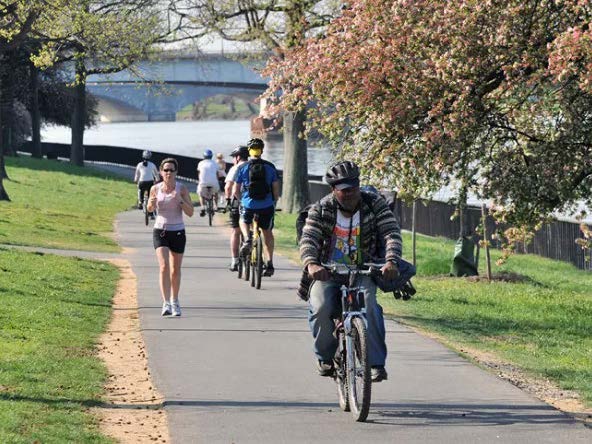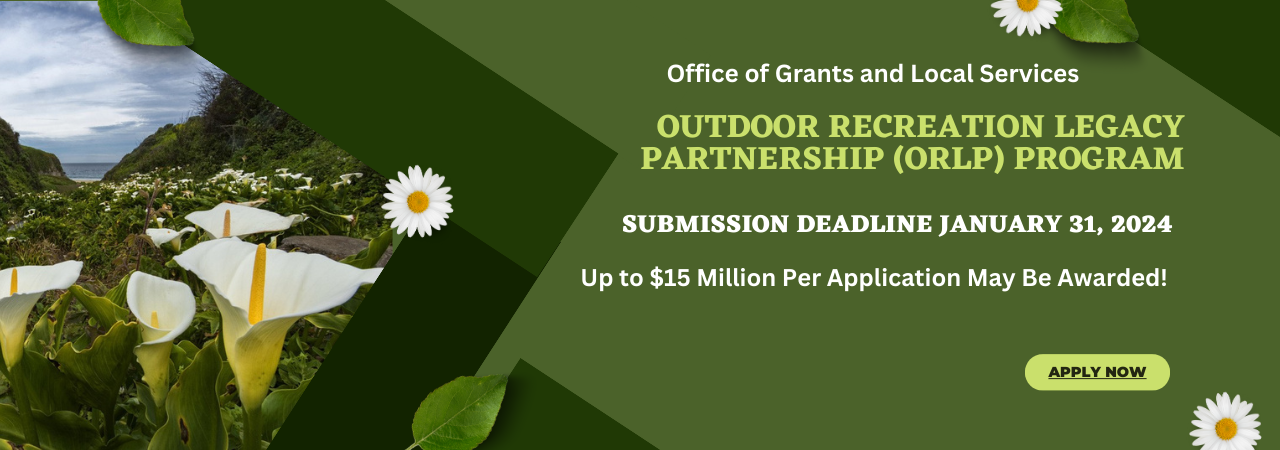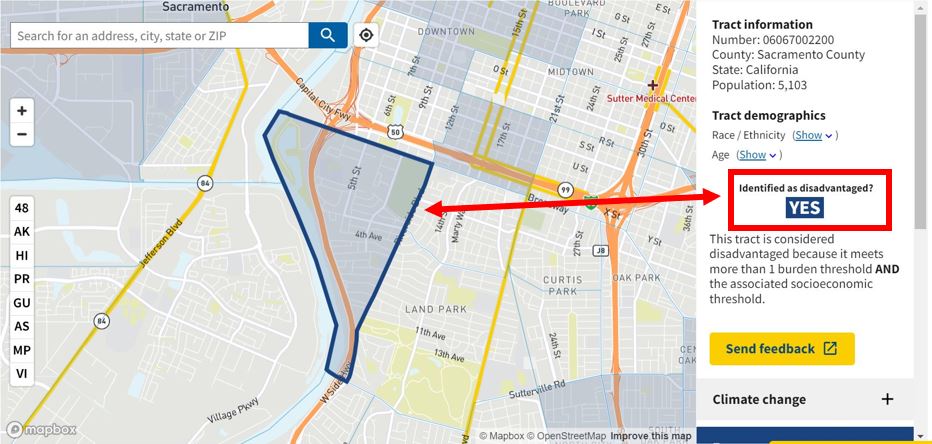Outdoor Recreation Legacy Partnership (ORLP) Program
 The Outdoor Recreation Legacy Partnership (ORLP) program was established in 2014 and is funded through the Land and Water Conservation Fund. ORLP is a nationally competitive program targeting grant assistance to help economically disadvantaged urban communities with no, or almost no, access to publicly available, close-by, outdoor recreation. Funds can be used for the acquisition and/or development of, or to substantially renovate obsolete, public parks and other outdoor recreation spaces.
The Outdoor Recreation Legacy Partnership (ORLP) program was established in 2014 and is funded through the Land and Water Conservation Fund. ORLP is a nationally competitive program targeting grant assistance to help economically disadvantaged urban communities with no, or almost no, access to publicly available, close-by, outdoor recreation. Funds can be used for the acquisition and/or development of, or to substantially renovate obsolete, public parks and other outdoor recreation spaces.

The Outdoor Recreation Legacy Partnership (ORLP) Program is a federal National Park Service (NPS) grant program. ORLP involves two competitive layers. First the California Department of Parks and Recreation's Office of Grants and Local Services (OGALS) competitively reviews applications. Second, OGALS forwards selected applications to NPS to compete in the nationwide competition.
Program Intent:
ORLP focuses on communities with little to no access to publicly available, close-by, outdoor recreation opportunities in urban areas. ORLP funds the acquisition or development of new parks, or substantial renovations to parks in economically disadvantaged cities or towns of at least 30,000 people.
Application Due Date:
Applications must be submitted online before 5:00pm on Wednesday, January 31, 2024.
Click the Submittable link below to begin the online ORLP application
https://ogals.submittable.com/submit
Video Tour of Online Application Platform
All applications must be submitted online through Submittable.Responses must be complete and submitted before 5:00pm on Wednesday, January 31, 2024. Additional documents will not be accepted after the deadline unless requested by OGALS
Amount Available:
Nationally, approximately $224.1M is available for the nationwide competition. Participating states are not guaranteed an award. The National Review Committee awards the most competitive applications received nationwide.
Maximum Grant Amount Request:
Maximum: $15 million per application
Minimum: $300,000 per application
Match Requirement:
Up to 50% of the total project cost can be requested through ORLP. For example, a $30 million total project can be funded with up to $15 million through ORLP.
- At least 50% of the total project cost must come from an eligible match source.
- All non-federal (state, local, or private) sources are eligible.
- The following federal sources are eligible as match for this program: Community Development Block Grants (CDBG), Fixing America's Surface Transportation (FAST) Act funding, and Readiness and Environmental Protection Integration Program (REPI) funding. Other sources of federal funding are not eligible for this program.
Eligible Applicants
- Cities
- Counties
- Park and open space districts, and special districts with authority to acquire, operate, and maintain public park and recreation areas.
- State agencies
- Federally recognized Native American Tribes
- Joint Powers Authorities where all members are otherwise eligible under LWCF.
Eligibility Requirements
- Projects must be located in incorporated cities and towns with at least 30,000 people.
- Projects must be located within a community (Census tract) that is determined to be disadvantaged per the Climate and Environmental Justice Screening Tool at https://screeningtool.geoplatform.gov.
- Projects must involve land acquisition, development, or both for outdoor recreation.
- Projects must be outdoor recreation areas and facilities open to the general public and not limited to special groups.
- Projects cannot be within a park or site that has received LWCF or ORLP grant funding within the last seven years.
Process and Timeline.
As a reminder, NPS requires all states to first conduct competitive reviews of all applications before forwarding selected applications to the national competition. For this reason, OGALS must have an application deadline months ahead of NPS’ application deadline.
1. OGALS Application Deadline: The application due date is January 31, 2024. OGALS will then conduct its internal competitive review process through February 2024.
2. OGALS Review Period: From March 2024 through April 2024, applicants with the most competitive applications will receive guidance from OGALS in consultation with NPS on how to complete the full federal application.
3. NPS Application Deadline: NPS requires that all states submit their selected applications for the national competition by NPS’ April 30, 2024, deadline.
4. NPS Selection Date: NPS national competitive review committee’s estimated selection date is November 1, 2024. If the national review committee selects the application, the applicant will advance to step 5.
5. Post Selection Federal Requirements: If NPS’ review committee selects the application, applicants must complete the Post Selection Federal Requirements before NPS will issue a funding agreement. This process generally takes one year to complete.
Environmental review note: Once an ORLP application is submitted to NPS, the project site is subject to NEPA and SECTION 106 approval. The land acquisition or construction (site prep, grading, demolition etc.) cannot begin until NPS approves the Post Selection Federal Requirements and provides a start-date (step 6).
OGALS will not start reviewing and processing NEPA and SECTION 106 packages until after the application is selected by NPS through the national competition.
6. NPS Issues Funding Agreement: NPS will conduct a final review of the application after the Post Selection Federal Requirementsare complete and then issue the funding agreement. NPS estimates the term of the funding agreement will be from 2025 – 2027.
The start date of the funding agreement marks when the project's land acquisition or construction can begin.
7. Project Completion: Applicant should plan to complete the project within three years after the funding agreement is secured. For example, if NPS issues the funding agreement in July 2025, the grantee has 3 years from that date to complete the project
Recorded Past Webinar Workshop:
Virtual application workshops were conducted in December 2023. Click the link below to listen to a recorded webinar.
LWCF Grant Administration Guide, August 2023
Grant Payment Forms:
All Payment Forms Combined , (Use DPR212F) includes these individual forms:
Provide a sample timesheet if seeking reimbursement for in-house employee services.
Project Completion Certification Form (Final payment only)
Funding Sources Form (Final payment only, if sources/amounts change from original submission)
Sample LWCF Boundary Map and Instructions (If revised from original submission)
Grant Administration Resources
A sign acknowledging the Land and Water Conservation Fund program as a funding source must be installed upon project completion and must remain in place in perpetuity. Additionally, if the total project cost is $500,000 or more, a sign must be installed during the construction phase as well. If appropriate, the same sign may be used both during construction and post completion. See LWCF Administration Guide for sign requirements.
- Required Language (construction)
- Required Language (post completion)
- Logo (JPG)
- Logo Guidelines
- Sign examples and additional guidance
LWCF outdoor recreation parks must remain accessible and protected for public outdoor recreation within the LWCF Boundary Area Map (boundary area) – formally the LWCF 6f3 Boundary Map of Record. The land within this boundary is considered to be under federal protection. LWCF Act at 54 U.S.C. §200301 et seq.
To verify that LWCF parks remain open, accessible, and maintained, OGALS conducts periodic compliance inspections. If operation and maintenance concerns are discovered, OGALS contacts the grantee.
Keep in mind, changes to the or within the boundary area may require converted property be replaced with non-park property of equal or greater recreational utility and value.
A conversion is the changing of the use of public park land to non-recreational purposes. Changes may need to be reviewed and approved by the National Park Services.
While some changes may not be considered a "conversion", National Park Service requires a process to review and document certain proposed changes. Contact your Grant Administration Project Officer if any of the following has occurred, or is being considered, for a park acquired or developed with LWCF funds:
- Changes to the LWCF boundary area. Such as a nearby public roadway expansion that encroaches on park property, construction of new buildings within the park, or any other changes that impact the amount of land available for outdoor public recreation use.
- Changes to the use of any portion of the park to private, commercial, or non-public outdoor recreation use.
- Construction of new or expansion of existing utilities (above and underground), rights of way and easements.
- Construction or installation of any indoor facility within the park that does not support outdoor public recreation, such as community centers, schools and pre-schools, gymnasiums, housing, police substations, and libraries.
- Closure (permanently or temporarily) of any portion of the park.
- Removal or replacement of a facility, obsolete or otherwise, developed with LWCF funds.
Changes that do not need to be reported to OGALS:
- Construction or expansion of indoor support facilities that directly support outdoor public recreation of the LWCF funded park, such as restroom or maintenance buildings.
- Removal, renovation, or replacement of any pre-existing outdoor recreation facility NOT developed with LWCF funds.
- Renovation of any facility developed with LWCF funds.
- Changes to landscaping, lighting, walkways.
- Expansion of parking lots that serve the park.
- Expansion of interior roads that serve the park.
Other outdoor recreation infrastructure improvements such as development of new outdoor recreation features.


